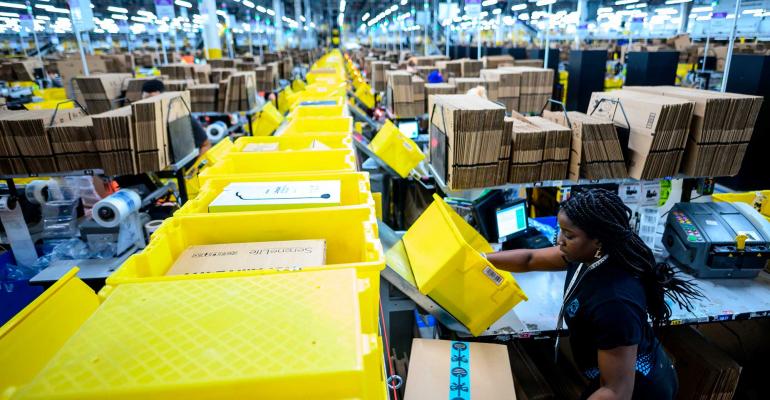Online sales shot up during the COVID-19 quarantine, causing many companies to rethink their logistics strategies. As a result, a number of e-commerce players are aggressively expanding their physical footprints to improve their fulfillment and delivery capabilities.
According to data from the U.S. Census Bureau, e-commerce sales accounted for 16.1 percent of total retail sales in the second quarter of 2020. On a non-adjusted basis, the estimated second quarter total for U.S. e-commerce sales was $200.7 billion, an increase of 37.0 percent from the first quarter and up 44.5 percent year-over-year.
That change in the retail marketplace is being driven by consumers and is here to stay, according to Greg Healy, senior vice president for supply chain solutions and workforce analytics in Colliers International’s Inland Empire office in Southern California. “We aren’t going back, so companies need to learn how to embrace and succeed in this new paradigm,” he says. A retailer might not necessarily need a storefront to succeed anymore, but does need a robust supply chain strategy.
Big-box omnichannel retailers, e-commerce companies, and third-party logistic companies (3PLs) that support e-commerce and fulfillment functions are among the top companies are aggressively expanding their supply-chain networks, he continues.
Demand for new space by Amazon exceeded that of all other e-commerce tenants put together, representing up to 50 percent of new market activity, says Miami-based Walter Byrd, executive managing director for industrial services at real estate services firm Transwestern.
Amazon reported a 13 percent increase in second quarter sales, compared to the first quarter, and a 40 percent increase in sales year-over-year. In a conference call with analysts, Amazon CFO Brian Olsavsky said that Amazon plans to continue its aggressive physical expansion, growing its network’s footprint by 50 percent in the last two quarters of the year. Amazon’s overall network of facilities, which only grew by 15 percent last year, includes the company’s fulfillment and distribution centers, offices, grocery stores and other physical properties.
According to Pete Quinn, national director, industrial services-USA, at Colliers International, other companies aggressively expanding their logistics networks, include: Quiet Logistics, Boeing, Grainger, DHL, Geodis, Target, HD Supply, Walmart, Lowes, Fedex, Pepsico and Frito Lay.
Both Lowe's and Home Deport are aggressively expanding their footprints to improve online sales fulfillment and delivery capabilities. Last month, Lowe’s announced plans to add 50 cross-dock terminals, seven bulk distribution centers and four e-commerce fulfillment centers over the next 18 months. As part of a $1.7-billion investment in the company’s distribution network, Lowe’s opened more than 13 industrial facilities across 13 U.S. markets over the past 18 months.
Home Depot is investing $1.2 billion to overhaul its supply chain, adding 170 new warehouses nationwide and 100 local hubs to handle large items, including furniture and appliances, reports the Wall Street Journal. The goal is to expand same-day and next-day delivery capabilities to 90 percent of the U.S. population.
Industrial leasing by food and beverage companies doubled in the second quarter to 11.4 million sq. ft., representing about 20 percent of the nearly 56 million sq. ft. of total space leased year-to-date, as grocery sales shifted to the online marketplace.
Target experienced a 195 percent increase in digital sales in the second quarter, 90 percent of which were handled by stores. In the wake of the pandemic-induced online sales boom, Target announced plans to expand its online grocery service and is testing a new sort center concept to better facilitate efficient last-mile delivery, reported Progressive Grocer. These sort centers would remove parcel sorting from stores, facilitate expansion of grocery offerings, enable higher throughput of e-commerce packages and more efficient shipping to lower costs per order. Target also plans to open new warehouses near key markets, including New York and Southern California, to more efficiently replenish stores in high-volume areas.
Additionally, 3PLs that serve e-commerce retailers, such as Fedex and DHL, are also expanding their logistics network to meet increasing demand by clients. El Segundo, Calif.-based 3PL Central, a warehouse management systems leader, shared data on its customer base with Logistics Management. This data indicated that 3PL e-commerce shippers experienced an 81 percent increase in order volume during the lockdown. Since 3PL Central processes more than 1 million orders per week, Patrick Burnson, executive editor of Logistics Management, suggests that these shippers provide a barometer for growth in the 3PL warehousing market.
With growing demand in already tight industrial markets, national vacancy is near record low levels at 5.5 percent, despite a high volume of new product deliveries. A total of 78.5 million sq. ft. of new industrial space was delivered nationwide in the second quarter—one of the highest quarters to date, with the Dallas/Fort Worth, Chicago and Houston markets accounting for 29 percent of total supply added, according to the second quarter of 2020 industrial report from real estate services firm JLL.

